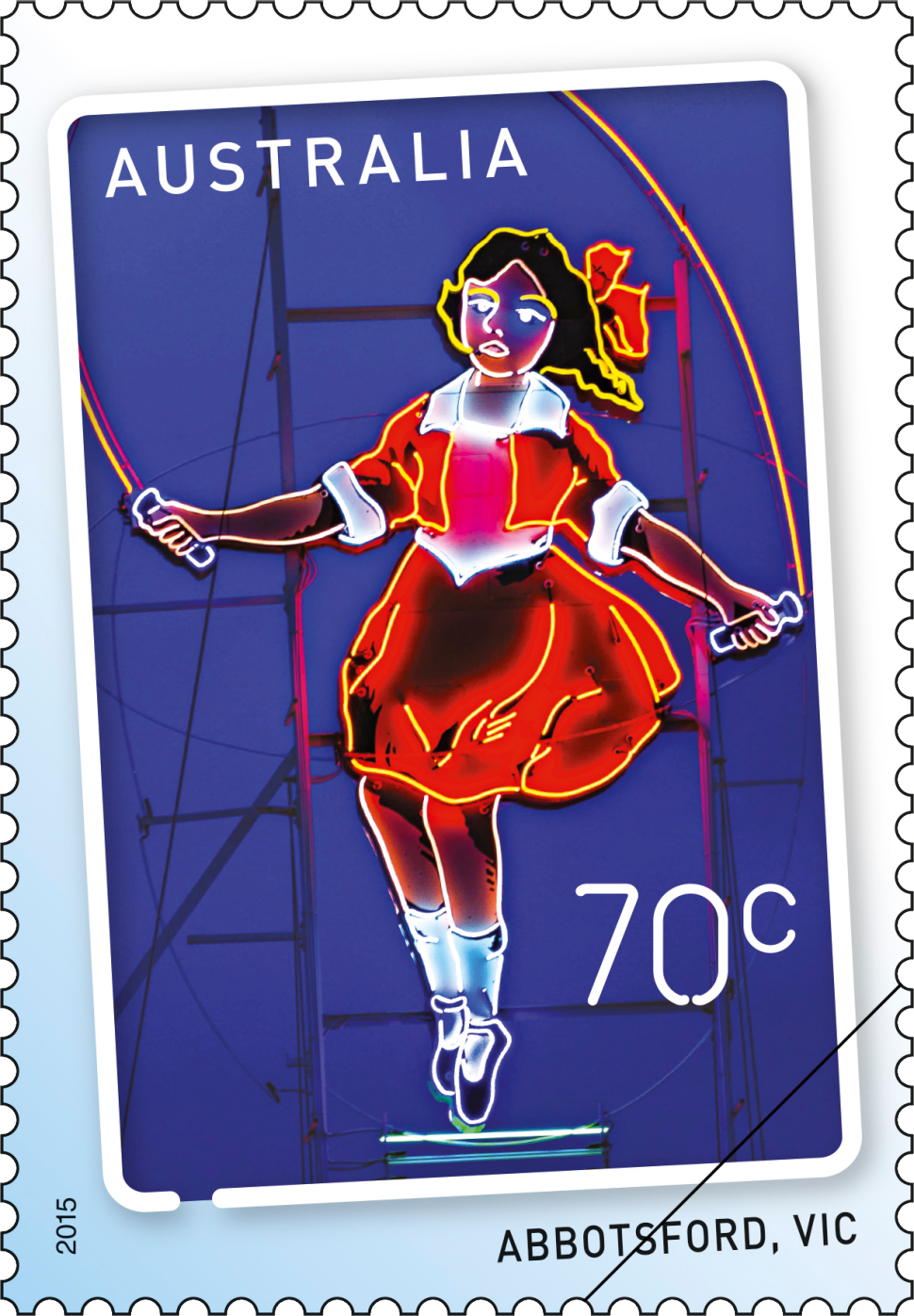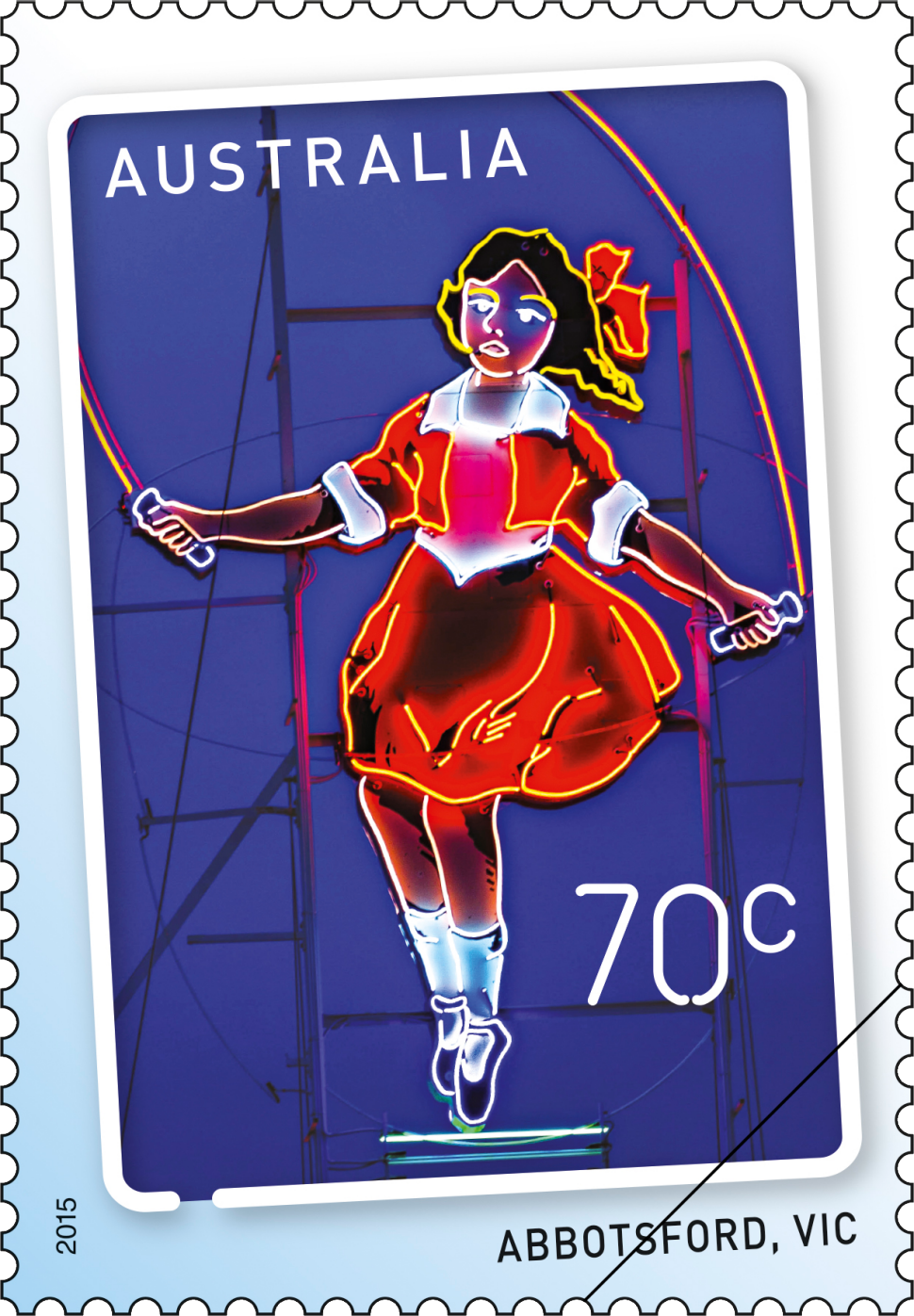This stamp issue celebrates three heritage-listed signs from the golden age of neon advertising in Australia, the 1930s to the 1960s.
Neon signs are intensely coloured electric signs lighted by long, luminous gas-discharge tubes that contain rarefied neon or other gases. Neon tubes were first demonstrated in December 1910 by Georges Claude at the Paris Motor Show, and were reportedly first used to advertise a barber’s shop, Le Palace Coiffure, on the Boulevard Montmartre in 1912. A neon sign for the vermouth Cinzano was also erected in the French capital, and the entrance to the Paris Opera was illuminated with neon tube lighting. Neon signage and advertising subsequently became popular throughout the world, particularly in America, where the lights of Times Square and Las Vegas became symbols of 20th century American urban modernity.
The patent for Claude’s neon illumination and advertising tubes arrived in Australia in 1924 and a patent was granted the following year. It has been claimed that the very first neon sign in Australia was in Darlinghurst Road, Kings Cross, in 1929. Other well-known Sydney neon signage included the animated Sharpies Golf House neon from the 1950s and the AWA signs of the 1960s. The Sharpies sign and one of the four AWA signs are now in the Powerhouse Museum, Sydney. For some reason a greater number of original neon signs have survived in Melbourne. Claude Neon’s Melbourne operation commenced in 1931 and several signs from the 1930s and early 40s still remain, including those of Newspaper House, Collins Street (1933), the Astor Theatre, St Kilda (1936), the Sun Theatre, Yarraville (1938), the old Pelaco factory, Richmond (1939) and Bosari’s Corner in Carlton (1942).
After World War II neon signage began to decline due to the introduction of new sign-making materials such as acrylic, the corporate takeovers of old Australian companies and redevelopment of old buildings. There was also a general indifference to our built urban heritage and many historic signs, such as Melbourne’s Allen’s Sweets sign, were destroyed. Originally erected in 1955 and redesigned in 1969, this spectacular 30 by 12-metre animated sign in South Melbourne used to light up the skyline from Princes Bridge. The 35-second sequence included cough lollies falling from an Anticol packet and a burst of fireworks with raindrops. Despite public outcry this sign was destroyed in 1987 when the Allen’s factory was demolished to make way for the Southbank development.
Today we are more conscious of the value of our historic neon signs, and this stamp issue features three that have been preserved and protected for the enjoyment of future generations of Australians.
Designer
John White, Australia Post Design Studio
Products released in this issue
- Stamp (2 x 70c, 1 x $1.40)
- Minisheet
- Cover (blank)
- First day cover (gummed)
- First day cover (s/a)
- First day cover (minisheet)
- Stamp pack
- Concertina Sheetlet pack
- Maxicard (3)
- S/A booklet of 10 x 70c
- Chequebook of 20 x 10 x 70c
- Roll of 200 s/a
- Strip of two
- Gutter (10 x 70c) Pink Poodle
- Gutter (10 x 70c) Skipping Girl
- Gutter (10 x $1.40) Dandy Pig
Technical specifications
- Issue date
- 1 September 2015
- Issue withdrawal date
- 31 March 2016
- Denominations
- 2 x 70c, 1 x $1.40
- Stamp design
- John White, Australia Post Design Studio
- Product design
- John White, Australia Post Design Studio
- Printer
- Ego print
- Paper - gummed
- Tullis Russell
- Paper - self-adhesive
- C100
- Printing process
- Lithography
- Stamp size
- 26mm x 37.5mm
- Minisheet size
- 105mm x 70mm
- Perforations
- 14.60 x 13.86
- Sheet layout
- Module of 50
- FDI postmark
- Bright, VIC 3741
- FDI withdrawal date
- 30 September 2015
The Skipping Girl, known as Little Audrey, is possibly the country’s best known neon sign. The original Skipping Girl, built by Neon Electric Signs, was erected in 1936 in Victoria Street, Abbotsford, Victoria, as an animated advertisement for Skipping Girl Vinegar. For over 30 years she skipped atop the Nycander & Co. factory but was removed in 1968 when the factory was demolished. The original Little Audrey was sold by Whelan the Wrecker to a local used car dealer. (Her ruined remains were discovered in the car yard in 1974 by Barry Humphries and Keith Dunstan). After public dismay at Audrey’s destruction a new near-replica sign was created in 1970 by Whiteway Neon for Benjamin’s Crusader Plate Company, a local business, who installed her on their Victoria Street roof. Little Audrey continued to be illuminated until 2002. In 2008 the National Trust ran a successful campaign to have the sign illuminated again, and in 2009 she was restored. Today Little Audrey continues to skip in full illuminated neon close to her original position in Victoria Street, Abbotsford.
After World War II, Queensland’s Gold Coast became a popular holiday destination for Australians. The Gold Coast’s first highrise was built in 1959 and was followed in the 1960s and 70s by other hotels and motels servicing the burgeoning tourist industry. These included icons such as Iluka, St Tropez and the Pink Poodle. The Pink Poodle, built in 1967 on the corner of Fern Street and the Gold Coast Highway, Surfers Paradise, was a popular honeymoon motel. The strutting Pink Poodle neon sign at the front of the motel exemplified the Gold Coast’s reputation for slightly racy, fantasy kitsch. The motel was demolished in 2004 but the famous sign (which was rebuilt in 1987) was saved, and in 2005 was nominated as a Queensland Heritage Icon by the National Trust. The illuminated Pink Poodle neon sign now stands in Fern Street near its original location.
The jaunty Dandy Pig neon sign was first erected in the 1950s on the Princes Highway, Dandenong, Victoria, for the Gippsland Co-operative Bacon Curing Company. It was one of the first animated signs in the district and for years the landmark Pig doffed his top hat to people passing through the gateway suburb. After closure of the factory in 1983, the much loved pig languished in storage before being restored and re-erected in 1993. In August 2013 the City of Greater Dandenong officially celebrated the re-instatement of the Dandy Pig at the redeveloped Dandenong Market as an acknowledgement of the sign’s social, cultural and historical significance to the community.Minisheet
This content was produced at the time of the stamp issue release date and will not be updated.








